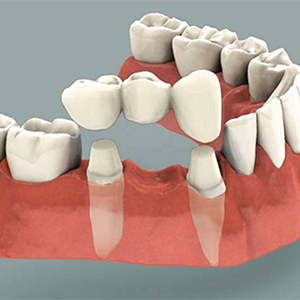Have you decided to replace some missing teeth and you are looking for the solution best suited to you? Would you like you like to have a dental bridge installed? Are you not sure what the difference is between a dental bridge and a dental implant?
The following article describes the features of dental bridges, the materials used to build them and the differences from dental implants…
What is a dental bridge?
It is a fixed dental prosthesis used to replace missing teeth. It is made from three elements: 2 abutments, one mesial and the other distal, and the dental bridge itself.
The abutment is the structure on which the dental bridge rests and it consists either of the two teeth neighbouring the missing one or of artificial roots. In the first case, the two natural teeth adjoining the missing tooth, or teeth, are filed in order to create the space needed for insertion of the capsule to which the dental bridge will be attached.
In the second case, the bridge is installed on dental implants or on artificial roots inserted in the maxillary or mandibular bone and capped with crowns.
The shortest bridges are those that replace a single tooth, being supported by the tooth in front of he missing one and the tooth that comes after it.
The materials
Dental bridges are an excellent solution for the replacement of missing teeth, in terms of both appearance and functional performance. They can be made from a number of different materials, including porcelain.
Porcelain is the material best suited to making dental prostheses, seeing that it is not only highly biocompatible but also ensures an appearance very similar to that of a natural tooth.
A bridge made from zirconium and porcelain guarantees an unsurpassable appearance, together with greater resistance, seeing that zirconium is an extremely solid material. It is also translucent, giving it an appearance even closer to that of natural teeth.
Alternatives
Dental bridges are an excellent solution for replacing missing teeth, but the same result can also be obtained with dental implants. These consist of artificial roots that are implanted in the bone to serve as the supports for the crown of metal and porcelain, or zirconium and porcelain, that replaces the missing tooth.
The implant technique does not call for the teeth neighbouring the missing one to be filed down, an operation that cannot be avoided when a dental bridge is installed.
The differences in the two approaches are significant: in the first case, outside elements are implanted in the bone, while, in the second, the prosthesis is installed on existing teeth that are filed to reduce their volume and allow them to be crowned with the capsule.
The choice between the two solutions for the replacement of missing teeth should be made on the basis of the patient’s needs and the state of his or her teeth.



